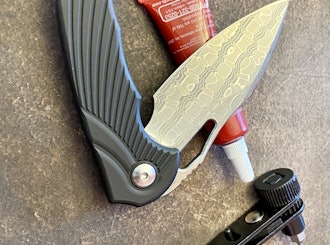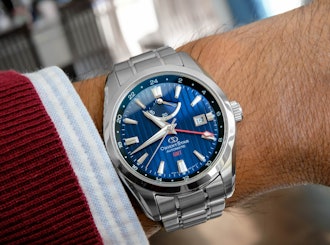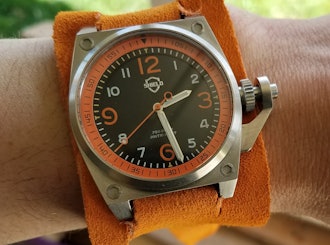Click to view our Accessibility Statement or contact us with accessibility-related questions










Showing 1 of 10 conversations about:
electricspacewizard
5
Sep 23, 2018
bookmark_border
Related Posts

legrospascal
Steinhart and massdrop
Hello, I was wondering if anyone have a contact with Steinhart watches to propose a drop or if these watches have been proposed on drop ? I find these watches desirable Thank you for help Regards Pascal
May 22, 2020

ChipmonkUK
Music workstation next level
Hi, I’m researching audio interfaces, headphones, DAC/amp etc. For connecting to my Yamaha PSR-S770 workstation to enable recording and saving of my music for my use. It’s mind boggling and potentially very expensive. I have a limited budget so most of my days are spent in search of quality bargains. Found myself here. Great products but shipping and taxes to UK are counteracting the deals to a large degree. Any suggestions would be greatly appreciated. Thanks.
Apr 22, 2020
Coaxial
Orient Star GMT watch.Can they remake watches that don't produce anymore?
Orient Star GMT WZ0071DJ
Aug 24, 2019
ksmith4546
Seiko kinetic mod- brand new watch ran for a few wks, until capacitor completely died. Installed new one ran same an died. Watch has been in my box for several yes now. After finding a few connection on where to get stuff, from this forum, watch works great. Found a newer movement on ebay cheap, so traded out just the movement kept face an hands. Replace capacitor for this movement an changed the flat mineral crystal with slightly domed sapphire with purple tint, I just love it. Change band to obviously, this is type of watch I always liked to wear to work in.
Mar 29, 2019
Leoanger
Homebrew Shield Strap
I'm just not ready to admit that this watch is too big for me. . A quick bit of rough prototyping. That suede is soo warm and soft (my winter watch? haha), but I don't know how it'll hold up if I break a sweat. A hybrid nato strap, if you will. If I want to stick with this concept, I'll have to lengthen the middle portion so that the rest of the strap conforms to my wrist (the lugs hold the pins pretty high) and then sew up most of the two cuts so it all keeps shape. Otherwise I could figure out a way to hold the watch down without such cuts. Closer to what I'm getting at (I folded the side bits). Still need to come up with a simple closure. Don't hold your breath, folks; I haven't lost my job, and my motivation for personal projects is ever an ebb and flow kind of thing. p.s. Why does it take five clicks to upload a stinkin' picture?
Mar 30, 2020
Trending Posts in More Community Picks

Graham88
Completely surprised by the lack of blade diversity here on Drop...
I’ve been a collector of Blades since before my teens, and a retailer coming up on 15… or maybe 20 years. Drop has really been kind of an interesting experience for me, because I do occasionally get to see some unusual tech and sometimes EDC items that otherwise I might not have been aware of. And maybe it’s because I have a deep love of cutlery and bladed weapons, but I find myself trolling through the site looking at it what’s available; and it’s just it’s pretty much the same. And the bladed community here is just always confused me.. every single knife is about the same, they’re almost all drop points and although the handle materials change and brands change.. it’s really just the same knife over and over and over again... occasionally you’ll see a tanto or a slight variant; but rarely… and almost never a serrated blade. And I’m just deeply amazed at this diversion of serrated blades. And I’m just surprised there isn’t more of a request for diversity here.... and I...
Mar 12, 2020
JellyDPhoto
Can we get Sony E-Mount or other mirrorless camera options please..
Would be nice to see some Sony E mount full frame cameras on here. I currently shoot with a A99 and they killed the lense path for better or more option lenses and now is all E-Mount. 🤔
Jan 13, 2020
RayF
There Are Pandas, and Then There Are Pandas.
And this isn't either of them! The Pandas we're talking about here, are watches, not bears. And what got me thinking about them (again) was a link posted this morning by @cm.rook who pointed a few of us to the very attractive (and not terribly priced) Yema "Rallygraph" Panda which, in it's most traditional arrangement, looks like the one on the left, but can also be had in the version on the right: The model on the left is a true Panda, while the model on the right is called a reverse Panda. The reason for that distinction is clear--Panda bears, only come in the first arrangement. Now at this point, everyone should be thinking about the most well-know Panda, The Rolex Panda, which is actually a Daytona, and among Rolex Daytonas, the most famous of which is the Paul Newman Daytona, which was famous first, because it was Paul's, and second because it sold at auction for $17.8 million (US Dollars). The story of that auction is well-known so I'll only...
Nov 8, 2019








I also develop my own film. It's not as difficult as it may seem and once you've got past the startup cost of buying all the necessary equipment, it's more affordable than sending off to a lab. It just takes more time. Sending your film to a lab or developing and scanning yourself is more a money-time tradeoff than anything else. Whichever one makes sense for you is going to depend on which of the two you have more of. And whether you find such a thing rewarding or just a chore. And how annoyed your roommates may or may not get with your constant hanging strips of film from the shower curtain rod to dry.
At first, with my Epson, I had the same issues you had with scans coming out with wildly varying color balances. I've since learned that to make my scans consistent, I must avoid as many automated scanner settings as possible. I manually adjust the input and output levels of each frame to capture the full dynamic range of the negative and leave the rest alone - absolutely zero white balance or color adjustments. This has given me much more consistent results.
I also save my scans as TIFF files for maximum flexibility in editing and aim for a flat scan that captures all the data I need instead of having a good looking scan in the first place. Then I edit the scans the same way I would any raw file in Lightroom. There's a learning curve for sure, but once you've figured out how to get consistent results out of your scanner, and how to pull the exact look you want out of those files, you'll be surprised how close you can get to the quality of professional lab processing with a dinky $150-200 scanner.
So my quick tips would be: - Use as few color adjustment settings on your scanner as possible. - Use your scanning software's histogram/levels adjustments to create a flat file with no clipping in the highlights and shadows. It may look dull and gray but that's what makes the file highly editable. - Save as a lossless format such as TIFF rather than a compressed format like JPEG. Achieve the look you want in post, not in the scanning software. Then save the edited file in whatever format and resolution you prefer. - Consider shooting medium format if your scanner can handle it. 35mm negatives push the limits of the resolving power in flatbed scanners. It's much easier to get great sharpness out of larger negatives. - Always reference photos you like the look of when editing. It's easy to make a small adjustment and be tricked into thinking you've gone far enough just because it looks drastically better than it used to. Editing is tricky that way. - Get tons of practice. You'll find your own best practices by experimenting. - Don't sleep on black and white. It's much less hassle to develop at home than color negative, grayscale files are smaller and scan more quickly than color files, and giant prints of gritty b/w medium format negatives look amazing.